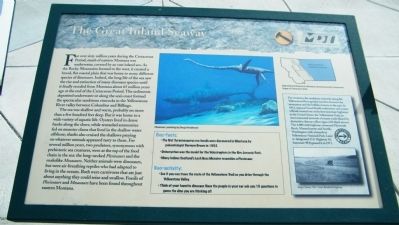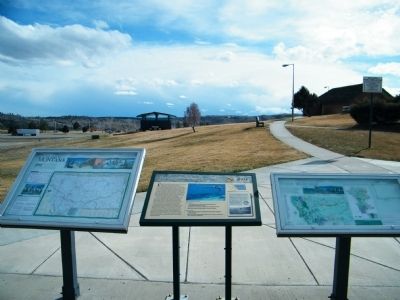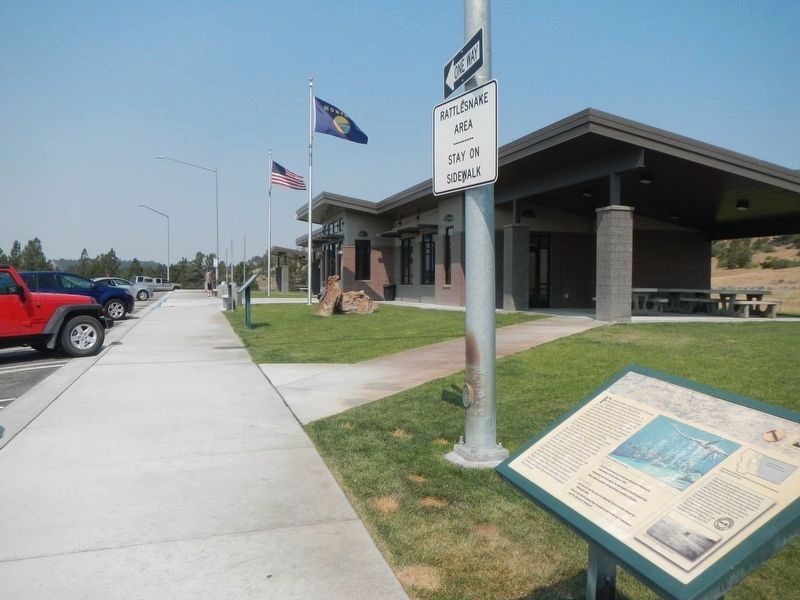Park City in Stillwater County, Montana — The American West (Mountains)
The Great Inland Seaway
The sea was shallow and warm, probably no more than a few hundred feet deep. But it was home to a wide variety of aquatic life. Oysters lived in dense banks along the shore, while tentacled ammonites fed on monster clams that lived in the shallow water offshore; sharks also cruised the shallows preying on whatever animals appeared tasty to them. For several million years, two predators, synonymous with prehistoric sea creatures, were at the top of the food chain in the sea: the long-necked Plesiosaurs and the snakelike Mosasaurs. Neither animals were dinosaurs, but were air-breathing reptiles who had adapted to living in the oceans. Both were carnivores that ate just about anything they could seize and swallow. Fossils of Plesiosaurs and Mosasaurs have been found throughout eastern Montana.
For centuries, the sandstone rimrocks along the Yellowstone River guided travelers between the mountains and the buffalo country to the east. In 1912, regional Good Roads enthusiasts and county officials created one of the first interstate highways in the United States, the Yellowstone Trail, an interconnected network of county roads blazed by distinctive chrome yellow signs with black arrows. The 4,000-mile highway connected Plymouth Rock, Massachusetts and Seattle, Washington with a branch to Yellowstone National Park. Later re-designated U.S. Highway 10, Interstate 90 bypassed it in 1971.
Erected by Montana Department of Transportation (MDT).
Topics. This historical marker is listed in these topic lists: Animals • Natural Features • Roads & Vehicles • Science & Medicine • Waterways & Vessels. A significant historical year for this entry is 1912.
Location. 45° 36.025′ N, 109° 3.958′ W. Marker is in Park City, Montana, in Stillwater County. Marker is on Interstate 90 at milepost 419,, 0.2 miles west of Ronan Ranch Road underpass beneath westbound I-90, on the left when traveling west. On left side of entrance road to Columbus Rest Area, on sidewalk leading to restrooms.
Touch for map. Marker is in this post office area: Park City MT 59063, United States of America. Touch for directions.
Other nearby markers. At least 8 other markers are within 8 miles of this marker, measured as the crow flies. The March of the Montana Column (a few steps from this marker); Bozeman Trail (a few steps from this marker); Columbus (a few steps from this marker); a different marker also named The Great Inland Seaway (approx. 0.2 miles away); Park City (approx. 0.2 miles away); a different marker also named The March of the Montana Column (approx. 0.2 miles away); Clark's Canoe Camp on the Yellowstone (approx. 7.6 miles away); United Methodist Episcopal Church (approx. 7.6 miles away). Touch for a list and map of all markers in Park City.
More about this marker. This marker is part of Montana's Geological Marker series.
Additional facts of interests and activities described on marker:
Geo-facts:
- The first Tyrannosaurus rex fossils were discovered in Montana by paleontologist Barnum Brown in 1902.
- Deinonychus was the model for the Velociraptors in the film Jurassic Park.
- Many believe Scotland's Loch Ness Monster resembles a Plesiosaur.
Geo-activity:
- See if you can trace the rout of the Yellowstone Trail as you drive through the Yellowstone Valley.
- Think of your favorite
dinosuar. Have the people in your car ask you 10 questions to guess the dino you are thinking of!
Map caption: Depositional features in Montana during the early Campanian Stage of Cretaceous time.
Photo caption: Plesiosaur painting by Doug Henderson
Photo caption: Fergus County 1922. Custer Battlefield Highway.
Additional keywords. Dinosaurs, Cretaceous Period
Credits. This page was last revised on February 4, 2022. It was originally submitted on March 26, 2010, by Rich Pfingsten of Forest Hill, Maryland. This page has been viewed 1,595 times since then and 55 times this year. Photos: 1, 2. submitted on March 26, 2010, by Rich Pfingsten of Forest Hill, Maryland. 3. submitted on January 23, 2022, by Barry Swackhamer of Brentwood, California. • Bill Pfingsten was the editor who published this page.


